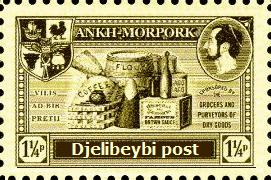|
There were three postal offerings from Djelibebi. A rather nice item is a carved stone postcard, addressed to the Guild of Embalmers in Ankh-Morpork. It is quite a weighty item, at least 8 mm thick and unsuitable for storing in an album; another of those DW items sent to test our ingenuity when it come to displaying our collections. I do not think the message has been translated, so there is a task for the long winter`s evenings to come. It came accompanied by a more conventional postcard showing the carving technique.
The next item is also quite ethnic, using papyrus for the letter. Gil the Embalmer has samples of his embalming salts which he hopes are of interest to the Ankh-Morpork Guild of Embalmers. Now the character in Pyramids is Dil the Embalmer, which is quite appropriate [Dill pickles - geddit?]. I suspect that this is a translation error, what is known in Discworld stamp collecting circles as a cock-up.
|
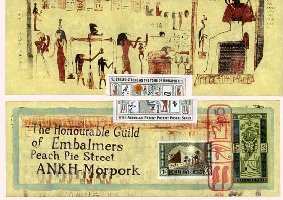
|
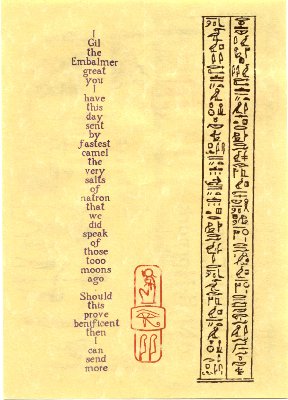
|
|
Wilfred researched the cancelation.
The frank is red, which in ancient Egypt had a double meaning: as a stimulating affirmation of the life-force, but also as a symbol for blood and gore generally, because of the fact that Seth had red hair and red eyes, and as you will undoubtedly all know he is the god of chaos and destruction. So far, so good. As for the various tokens in the cartouche:
The upper one is without doubt the written version (we would call it a letter or a word, I suppose) of the sungod Ra. As the sun is supposed to shine on everything and everybody, even it is not as often as we might wish, this makes a nice and positive general symbol. As to the lower token, this is a stylized ostrich feather and is a feature of both the God of Air (Sjoe) and the Goddess of justice, truth and the genral Worldorder, whatever that may be. It should be noted that both these tokens are usualle mirrored in Egyptian scripture, so this poses a problem regarding the middle token, which depicts one of the eyes of Horus.
Now Horus had two eyes, the left eye stood for the moon, womanpower and the past (makes you think, doesn't it!) and the right eye was symbolic for the active, creative and male powers of the sun and the future (hah!).
Together the eyes stand for knowing everything. As an amulet the eye of Horus also promised life eternal.
You will see the problem here. If the seal was carved in the same way it should appear on the frank, the frank is mirrored as are the other two words, and what appears as the left eye is probably meant as the right one.
Well, whatever. I couldn't find any relation to either a date, a place or anything else conncted with a postal service. So if there is an Egyptologist among you all, please enlighten me! I couldnt get any further than the conclusion that if if the sun shines too long on the dead body it's bad for the embalmers business, but because they know everything they will succeed in doing a good job regardless and thus insure that the deceased will be judged fairly (because the hart will have to be weighed against the feathers and if it's too heavy because of sinful living the poor deceased will be eaten by Ammut instead of entering the Duet (think paradise).
Hilary summarised it : We are informed that it signifies that a god watches over the written word, an appropriate - if optimistic - motto for the fledgling Djelibeybian postal service.
|
|
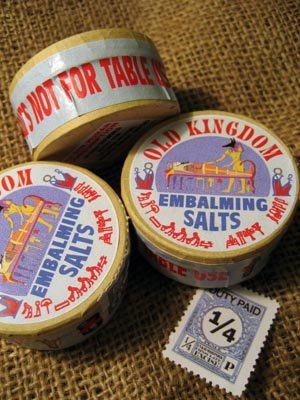
For collectors who just have to everything, samples of the embalming salts to accompany the letter were available. Ankh-Morpork tried to capitalize on this by charging duty on these imports. Little did they know that this would make the salts even more collectable because it offered a chance to obtain the little used farthing Duty stamp.
The third item was a cover in the Consulate series.
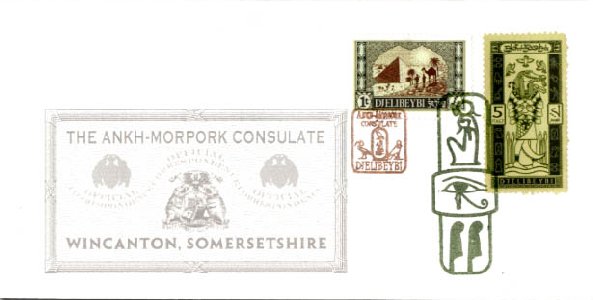
|


